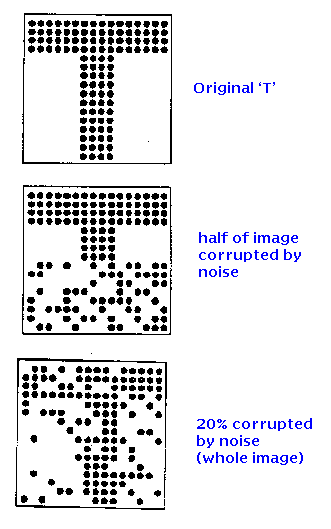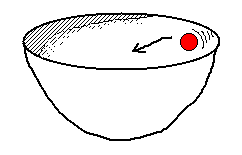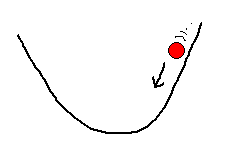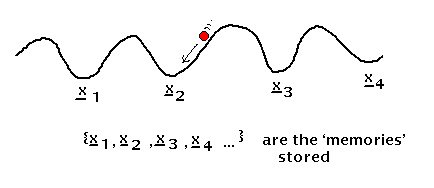|
¡@ |
1. Associative memory |
¡@ |
|
¡@ |
The nature of associative memory`Remembering' something in common parlance usually consists of associating something with a sensory cue. For example, someone may say something, like the name of a celebrity, and we immediately recall a chain of events or some experience related to the celebrity - we may have seen them on TV recently for example. Or, we may see a picture of a place visited in our childhood and the image recalls memories of the time. The sense of smell (olfaction) is known to be especially evocative in this way. On a more mundane level, but still in the same category, we may be presented with a partially obliterated letter, or one seen through a window when it is raining (letter + noise) and go on to recognise the letter. slide of `T's
The common paradigm here may be described as follows. There is some underlying collection of data which is ordered and interrelated in some way and which is stored in memory. The data may be thought of, therefore, as forming a stored pattern. In the recollection examples above, it is the cluster of memories associated with the celebrity or the phase in childhood. In the case of character recognition, it is the parts of the letter (pixels) whose arrangement is determined by an archetypal version of the letter. When part of the pattern of data is presented in the form of a sensory cue, the rest of the pattern (memory) is recalled or associated with it. Notice that it often doesn't matter which part of the pattern is used as the cue, the whole pattern is always restored. Conventional computers (von Neumann machines) can perform this function in a very limited way. The typical software for this is usually referred to as a database. Here, the `sensory cue' is called the key which is to be searched on. For example, the library catalogue is a database which stores the authors, titles, classmarks and data of publication of books and journals. We may search on any one of these discrete items for a catalogue entry by typing the complete item after selecting the correct option from a menu. Suppose now we have only the fragment `ion, Mar' from the full title `Vision, Marr D.'. There is no way that the database can use this fragment of information to even start searching. We don't know if it pertains to the author or the title, and even if we did, we might get titles or authors that start with `ion'. The kind of input to the database has to be very specific and complete. A physical analogy with memoryThe networks that are used to perform associative recall are specific examples of a wider class of physical systems which may be thought of as doing the same thing. This allows the net operation to be viewed as a the dynamics of a physical system and its behaviour to be described in terms of the network's `energy'. Consider a bowl in which a ball bearing is allowed to roll freely bowl and ball bearing in 3D
This is more easily drawn using a 2D cross section 2d X-section of bowl
Suppose we let the ball go from a point somewhere up the side of the bowl with, possibly, a push to one side as well. The ball will roll back and forth and around the bowl until it comes to rest at the bottom. The physical description of what has happened may be couched in terms of the energy of the system. The ball initially has some potential energy. That is work was done to push it up the side of the bowl to get it there and it now has the potential to gain speed and acquire energy. When the ball is released, the potential energy is released and the ball rolls around the bowl (it gains kinetic energy). Eventually the ball comes to rest where its energy (potential and kinetic) is zero. (The kinetic energy gets converted to heat via friction with the bowl and the air). The main point is that the ball comes to rest in the same place every time and this place is determined by the energy minimum of the system (ball + bowl). The resting state is said to be stable because the system remains there after it has been reached There is another way of thinking of this process which ties in with
our ideas about memory. We suppose that the ball comes to rest in the
same place each time because it `remembers' where the bottom of the
bowl is. We may push the analogy further by giving the ball a
coordinate description. Thus, its position or state at any
time is given by the three coordinates If we now use a corrugated surface instead of a single depression (the bowl) we may store many `memories'. X-section through corrugated surface
If now the ball is started somewhere on this surface, it will eventually come to rest at the local depression which is closest to its initial starting point. That is it evokes the stored pattern which is closest to its initial partial pattern or cue. Once again, this is an energy minimum for the system. There are therefore two complementary ways of looking at what is happening. One is to say that the system falls into an energy minimum; the other is that it stores a set of patterns and recalls that which is closest to its initial state. If we are to build a network which behaves like this we must include the following key elements ¡@
¡@ |
¡@ |
|
¡@ |
|
¡@ |



